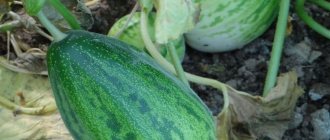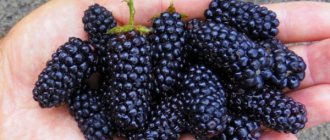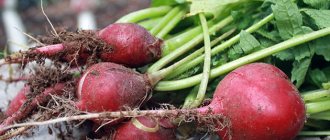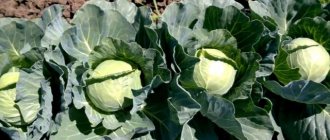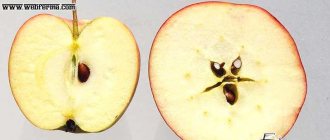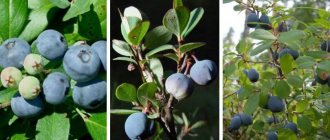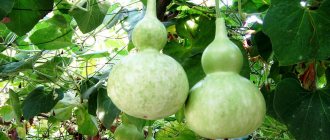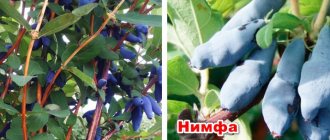Planting a variety
Cucumber loves the sun, so choose a well-lit area without drafts. It should not be planted next to melons to prevent cross-pollination. In addition, when choosing a place to plant, it is worth considering what vegetables grew on the site last year. Pumpkin plants are bad predecessors. It is not recommended to plant them in the same place twice.
Soil preparation
The soil must be fertilized, since cucumber requires fertile soil. To do this, in the fall, in dug up beds of 1 square meter. m add 25 g of superphosphate, 12 g of potassium sulfate, 15 g of ammonium nitrate and 0.5 buckets of humus. If the soil is not saturated with useful substances, the fruits will not grow large and the taste will not please you.
Planting method
The vegetable is planted both by seedlings and by sowing seeds. If the second method is chosen, then it is carried out at the end of May. Cucumber seeds are pre-soaked in a weak solution of potassium permanganate for 20 minutes. The size of the recess should be 1.5 cm, and the distance between the bushes should be 1 m.
The harvest can be harvested earlier if the crop is planted as seedlings. To grow it, the seeds are sown in pots in early May. Some gardeners do this in early April. In this case, the fruits are harvested at the beginning of summer.
Seedling
Seedlings are grown as follows:
- They take the vessels. For example, cups. Fill them 3/4 with peat and humus (you can buy a special soil mixture).
- One seed is placed in each.
- They are deepened by 2-2.5 cm.
- Put everything together in a box and cover it with film.
They are planted in a permanent place after about a month, when the temperature reaches 20°C. Seedlings are grown both in greenhouses and in open ground, but often the cultivation of a hybrid of cucumber and melon is carried out in greenhouse conditions, because temperature changes can adversely affect the growth of bushes. When grown in a heated greenhouse, the crop can be harvested for a long time, but not during the cold season.
When planting, you need to be careful not to damage the roots, from which you should not remove the earth ball. It is necessary to deepen it as much as possible, then a powerful root system will be formed. For better adaptation of plants in a new place, they are covered with non-woven material.
Composition and properties
Cucumber is characterized by high nutritional value and has a rich chemical composition:
- vitamins A, C, E, PP, group B;
- minerals: magnesium, sodium, calcium, potassium, iron.
Benefits and harms
Eating cucumber fruits has a beneficial effect on the human body:
- destroys free radicals;
- has an antisclerotic effect;
- normalizes the functioning of the digestive system;
- removes excess salts and cholesterol;
- speeds up metabolism;
- rejuvenates the body;
- has mild choleretic and diuretic effects.
No information is provided about the dangers of cucumber. Individual intolerance is possible. Therefore, introduce a new product into your diet with caution.
This is interesting:
Cucumber cultivation and care
Preparing seeds, sowing seedlings
It will be good if the seeds are allowed to germinate before planting. To do this, place the seeds in a damp cloth or cotton wool and put them in a warm place. This will improve germination and also help determine the suitability of the seeds. In general, when growing seeds in seedlings, you don’t have to soak or germinate them. But if you plant directly into the ground, it is better to do it with sprouted seeds.
When planting, the seeds are placed on the edge, the seeding depth is 1.5-2 cm. Immediately after planting, it is necessary to water with warm water, and then do not water for 2-3 days.
Location, soil, lighting
Ogurdynia loves warm, sunny places, sheltered from the wind, fertile and light soil; it is good to add compost to the soil. The soil should be light and retain moisture well.
In the middle zone it is grown by seedlings, however, when grown in a greenhouse, it is quite possible to plant the seeds directly into the ground at the beginning and even the end of May. The distance between plants is from 50 cm to 1 m.
Cucumber care
While growing green mass, the plant needs regular watering, with a small amount of water, but the soil must be kept moist at all times. The root is superficial, so you need to water it a little, but often. Ogurdynya loves mulching - compost, hay, straw, it’s a good idea to sprinkle it with river sand. Feed with fertilizer containing nitrogen.
When the fruits begin to form, watering is reduced, and later stopped altogether, so that the fruits gain sugar content. At the initial stage of fruit formation, fertilizing with potassium fertilizers is good.
It is worth remembering that cucumber does not like frequent fertilizing and it can negatively affect the harvest.
Topping. In general, this cucumber variety can easily grow and produce a good harvest without pinching. However, bush shaping is recommended.
To get more fruits, the plant should be formed correctly: the main stem is pinched above the fifth leaf, and the side shoots behind the seventh or eighth. There are other recommendations for pinching, namely after the appearance of 3 or 4 fruits. Pinching the main stem stimulates the formation of side shoots with ovaries. But even here, gardeners usually leave 2-3 ovaries on the shoot, so that their excess quantity does not take too much energy from the mother stem to ripen excess fruits.
In greenhouses we tie the plant up.
Cold and heat resistance
Cucumber cannot boast of heat resistance - despite the fact that this crop is very light-loving, at air temperatures above +30°C its ovaries fall off. Therefore, on particularly hot days, plantings are shaded.
The cucumber hybrid has sufficient cold resistance for cultivation in the Middle Zone. To increase this indicator, you can use the following agricultural practices:
- when planting seeds in open ground, they are pre-hardened by one of two well-known methods: variable temperatures or cooling;
- When growing seedlings, young seedlings need to be taken outside for a short time in different weather conditions. This way they will also be hardened.
Hardening the seeds will allow them to be planted in colder soil (+100C), so cucumbers can be planted in open ground earlier.
Ogurdynya
This two-in-one vegetable is most widespread in Italy, where it is called the “Mandurian round cucumber,” or manduria for short. For many years now, the mysterious vegetable has provoked much controversy regarding its origin. But, most likely, cucumber still cannot be called a hybrid of melon and cucumber.
Green Dragon cucumber fruits. Lyudmila Svetlitskaya
Its scientific name is Cucumis melo (melon), while the Latin word for cucumber is Cucumis sativus. From which it follows that cucumber is a type of melon, which, however, is a close relative of cucumbers.
In any case, this does not prevent you from using the young fruits of this crop like fresh cucumbers, and enjoying fully ripened “cucumbers” like melons. Out of curiosity, we tried to use cucumber in both forms.
In mid-summer, its young ovaries pleased us with their harmonious taste. Briefly, they can be described as an “improved” cucumber. Unripe cucumber fruits have a fresh cucumber aroma, delicate skin that does not need to be trimmed, and a pleasant, slightly sweet taste. In addition, “cucumbers” are never bitter, even if the plant does not receive enough water.
It is believed that cucumber is also suitable for pickling and pickling. But we were sorry to use the precious greens in salads or preparations, because subsequently they grew into delicious little melons, which were in no way inferior to an ordinary melon with very juicy and sweet pulp.
Manduria melon is an ideal option for regions where large melons do not ripen and cannot gain sweetness. Ogurdynya has a short growing season and can be grown even in cool summers.
Interesting varieties of cucumbers
With increasing popularity, more and more varieties and hybrids of cucumber appear on sale: “Nectarine”, “Carosello”, “Queen Anna”, “Green Beauty”, “Fasano”, etc. Last year we grew two popular varieties of manduria: “Green Dragon” and “Lazyman’s Dream”, and both varieties did not disappoint us.
The “Green Dragon” cucumber has an elongated shape and an unusual “watermelon” skin pattern, and the “Lazyman’s Dream” is similar in color and shape to the popular “Collective Farmer” melon. Both melons taste equally good.
Young cucumber “cucumbers” on a branch. Useful Tropical Plants
Features of growing cucumbers
Cucumber farming technology is not complicated. It is better to sow it directly into the ground as soon as the threat of return frosts has passed - approximately in mid-May. Like all members of the pumpkin family, the crop prefers organic-rich soils and regular watering during fruit set.
Berry vines are not too long (up to three meters) and can spread along the ground or entwine a trellis
It is important to protect the crop from birds. The first ovaries form 70 days after seed germination. Practice has shown that in rainy years, cucumber ovaries are susceptible to bacterial rot, so it is important to promptly remove diseased fruits and treat them with medications.
Manduria is very prolific, and with regular harvesting, up to 20 small melons weighing from 1 to 2 kilograms can be collected from one bush. Do not forget to harvest the cucumbers in a timely manner, since overripe fruits become severely cracked. Due to their belonging to the same family, it is better not to plant manduria next to pumpkins, cucumbers and zucchini to avoid cross-pollination.
Read the continuation of the list of exotic vegetables that I grow myself and recommend to others on the next page.
Cultivation of cucumbers
Scientists and breeders are constantly working to develop new and improve existing plant species. Cucumber is a hybrid vegetable, a mixture of cucumber and melon of early varieties. Many people love the early ripening fruit; they recommend it to their friends and acquaintances, praising its beneficial properties and taste.
Benefit
The fruit has low calorie content and a rich composition that helps strengthen the immune system. This vegetable is especially useful for children. You can make a delicious sweet puree from it.
The benefits of the hybrid are also appreciated in the beauty field. It makes excellent masks and wraps.
Description
Fruits 8-12 cm long appear on the bush in June - early July. Green, they taste and look like cucumbers. When ripe, the fruit becomes similar in flesh to a melon. The taste of cucumber can even be banana or caramel, and the color depends on the variety.
The plant can reach 3 m in length, which is why it is compared to vines, and some people plant it along the hedge.
Varieties
Today there are already 15 varieties of hybrids on the market. You can easily choose the appropriate type for your site that matches your preferences in taste, size, etc. Don't settle on just one variety.
The following varieties of cucumber are popular: Osobaya, Candy, Belaya, Orenburgskaya, Manduria. These plants have strong stems and a lot of foliage, the weight of the fruit reaches 3 kg.
The following types of vegetables have a serpentine shape and unusual color: Taro, Melanflechuosus Sakhio, Mark Duck Green. These fruits are up to 90 cm long.
An elongated shape and large size are characteristic of the varieties Alexandria, Banana, Caramel, Novinka, Fisano, Larton, Pineapple, and Orange Banana.
Growing
There are many varieties of vegetables
When growing, it is necessary to take into account some characteristics of the crop. The plant “loves” a warm and dry climate, so a well-lit, ventilated and unshaded place, protected from drafts, is suitable.
The soil
The soil for cucumbers is the same as for cucumbers: loosened and capable of absorbing and retaining water. The plant is moisture-loving, so proper watering is especially important in the initial stages of its growth.
Landing
You can grow vegetables using seedlings or by sowing seeds in the ground. The planting method depends on your region of residence:
- for areas with a mild climate, they choose to plant seeds in the ground, doing this in the second half of May;
- in regions where the warm season is delayed and the summer itself is short, it is better to plant the plant using seedlings.
This culture is cold-resistant. Suitable for growing in a greenhouse.
Seed preparation
Before planting in open ground, cucumber seeds must be soaked in a weak solution of potassium permanganate for half an hour. This measure will promote their rapid germination and determine which of them are unsuitable for planting.
Sowing
In the first stages, the issue of soil irrigation requires a lot of attention. Enough moisture will allow the seeds to germinate.
They are planted to a depth of 2 cm at a distance of 50-100 cm from each other.
When 5-6 leaves are formed on the plant, pinch off the top. This allows it to send out side shoots. By sprinkling some of them with soil, you promote the formation of additional roots, which makes the crop stronger and allows it to receive more moisture and nutrients from the soil.
Plants are easy to care for
Caring for crops consists of several simple rules. It is necessary to water the plant once a week, in a greenhouse - even less often (2 times a month)
It is important to do weeding regularly. It is better to remove unnecessary grass using pruners
Fertilizers are needed by the crop only during the growth stage. When the first ovaries appear, fertilizing must be stopped. The optimal type of feed would be manure, ash or minerals. They are applied around the shoots, being careful not to touch the plant itself.
Difficulties in growing
The main difficulty when growing is to provide the crop with a sufficient amount of water, avoiding waterlogging of the soil. The miracle plant is prone to bacterial diseases and ovary rotting. Before the next watering, look under the leaves; perhaps the soil has not yet dried out and it needs to be put aside.
Harvesting
Vegetables can be harvested within 1.5-2 months after planting. The crop bears fruit until the first frost. One bush can produce up to 20 fruits weighing 1-3 kg, depending on the variety.
It is recommended to store cucumbers in a dark and ventilated area. The air temperature should be around 0 °C. In such conditions, the fruits will be able to “lie” for about 50 days.
Attractive qualities and varieties of cucumbers
And the reviews are as follows: first of all, cucumber spoils vegetable growers with a variety of shapes, colors and flavors. Its fruits have the rare ability to change their shape, color, taste and aroma depending on the stage of ripeness. At an early stage, they are no different from cucumbers and have a pleasant cucumber smell. At this time, they can be eaten fresh, prepared delicious salads, salted, pickled, used for all types of processing, during which they do not lose their original color and aroma.
When ripened, these fruits experience a miraculous transformation: they become like a melon and acquire a unique taste and melon aroma. The orange-yellow, juicy, sweet cucumber pulp with an orange-honey or banana flavor is a real treat for children. The most excellent preserves, the sweetest candied fruits, amazing jams, marmalades and compotes are prepared from it, and the amazing taste of dried slices of this fruit, as vegetable growers who have already mastered it say, cannot be expressed in words.
And one more thing: cucumber has a high yield, sufficient early maturity (1.5-2 months from planting to harvesting), cold resistance (although some advise growing cucumber in a greenhouse or hotbed in order to guarantee a harvest) and disease resistance. Many consider this vegetable to be the crop of the future and directly urge experimental enthusiasts not to stay away from growing cucumbers: “You will fall in love with this plant from the first days. It is simply a must for growing here in Russia. Try it and you will like it."
It would be surprising if there weren't some pretty negative responses. Something reminiscent of a line from a famous comedy film - “What a disgusting thing this jellied fish of yours is!” Presumably, this is because the real (desired) cucumber was obtained by crossing the best productive varieties of cucumbers and very early, sweet varieties of melons, which have proven themselves when grown in any climatic conditions.
When breeding this plant, only the best representatives of these two beautiful and popular crops were carefully selected for their beneficial properties and qualities. If this principle of crossing is violated, then naturally the quality of the vegetable will be completely different. The conclusion suggests itself: when mastering this type of plant, you should choose the best varieties of cucumbers.
It is possible that you will have to experiment with several varieties and choose the ones you like. But, I would like to think, this will not stop our enthusiastic vegetable growers. Currently, the following varieties are cultivated in Russia: Alexandria, Bananovaya, Caramel, Candy, Novinka, Fisano, Manguria, Pineapple, Improved, Special, Green, White. Plants of these varieties are powerful, with great fruiting potential. The fruits are from 30 to 50 cm long, wide, torpedo-like, very tasty, crispy, almost without seeds, they can be eaten directly with the skin.
Ogurdynya Orenburgskaya is also recommended for cultivation. This plant is strongly climbing, reminiscent of a cucumber, but the vines are stronger, with large melon-like leaves. Its unripe fruits (greens) up to 12 cm long can be picked at the end of June - beginning of July. The fruits are dark green, densely pubescent, tightly adjacent to the vines. As it grows, the fluff thins out and almost disappears. Can greens be eaten fresh or processed? - salt, pickle, preserve. By August they are fully ripe, become juicy, aromatic, two-kilogram melons of an elongated oval shape, painted yellow, and sometimes become netted. One bush grows up to 10-12 melons.
Ogurdynya
Rules for harvesting and storing crops
A special feature of cucumber is that it can be harvested at the initial stage of its ripening or when the fruits are fully ripe. Vegetables on the bush are formed continuously until autumn, so you can collect cucumber melon throughout the summer.
A list of basic rules for harvesting this crop is presented below:
- to prepare salty dishes, vegetables need to be cut 30–40 days after planting the seedlings, when the fruits do not differ in taste from cucumbers;
- To make cucumber jam, the fruits need to be picked only after they are fully ripe;
- ripe vegetables must be removed from the bush in a timely manner so that they do not draw out nutritious juices from it;
- Harvesting ripened fruits must be done carefully, trying not to damage the delicate skin of the vegetables;
- To extend the shelf life of fresh fruits, it is recommended to leave a stalk up to 5 cm long when cutting them.
Important! Cucumber fruits can be stored fresh for 50 days in a well-ventilated and dark room with an air temperature of about 0
°
WITH.
Plant with seeds or seedlings
The unusually shaped fruits also have an unusual taste.
Photo: fermilon.ru Ogurdynya - photo, description of the species:
- A hybrid of modern selection, cucumber (lat. Melo orientalis or Melo cucumber) began to be grown in Central Asia. The bush reaches 2 m in height and is hung with rare fruits that resemble cucumbers in appearance. The leaves are also similar to cucumber leaves, only slightly larger.
- The size and taste of the fruit depend on the stage of ripeness. At the very beginning of ripening, in appearance and taste, these are more like cucumbers. Ripe fruits reach 60-80 cm in length, turn yellow and become melon-like. When cut, they are distinguished by a small number of seeds and a thick layer of pulp. The skin is very thin, like an apple, which indicates a short shelf life.
- When fully ripe, the flesh turns white-yellow and exudes the aroma of a real melon. The taste is unusual and includes many flavors of melon, banana, orange, cucumber and honey.
- At the initial stage of ripeness, salads are prepared from the fruits, they are canned and consumed fresh. Ripe fruits are best consumed fresh or made into jams and preserves.
Mulch protects the soil around the plantings from drying out. Photo: ogorodnik.com
The author of the video talks about the features of an exotic vegetable - cucumber. In appearance it looks like a cucumber, covered with villi on top. The taste in the green ripeness phase is reminiscent of a cucumber crossed with a zucchini:
- https://7ogorod.ru/paslenovyj-i-tykvennye-ovoshhi/ogurdyna.html
- https://zelenj.ru/armyanskij-ogurec.html
- https://fermoved.ru/ogurtsyi/ogurdynya-chto-eto-takoe.html
- https://ogorod-bez-hlopot.ru/armyanskij-ogurec-so-vkusom-dyni-opisanie-i-xarakteristika-otzyvy.html
- https://moyadacha.temaretik.com/1751395767912500126/harakteristika-ogurdyni—vyraschivanie-ovoscha-v-otkrytom-grunte/
- https://qlumba.com/sad/frukty/1753-ogurdynya
- https://fermilon.ru/sad-i-ogorod/ovoshhi/ogurdynya-otzyvy-sorta-posadka-i-uhod.html
- https://znay.co/393-ogurdynya-chto-ehto.html
- https://agrouchastok.ru/ovoshhi/ogurcy/armyanskij.html
- https://sampit.ru/ogurdynya-osobennosti-vyraschivaniya-gibrida-ogurca-i-dyni/
Our experience in growing cucumbers
We began cultivating this culture in the late 90s, and to this day we cannot get enough of it. But it is better to grow it in a greenhouse, since in open ground plants often die due to weather conditions.
About cucumber varieties
Last season, 3 types of cucumber varieties were grown:
- white,
- green
- green improved.
They have few differences:
Listen to the radio broadcast:
How to achieve a good harvest of cucumbers. (The main summer resident of the country Andrey Tumanov)
- white young fruits are white, when ripe they are bright yellow,
- the green one has green and yellow,
- the improved one has the same, only the fruits are 2 times larger.
I’ll tell you about the care and cultivation and taste of cucumber.
We sow cucumbers in early April, and after two months we taste the first fruits, which taste like cucumbers: tasty, sweet, crunchy. But we have enough cucumbers for every taste, so we decided not to touch the cucumbers anymore, let them grow until the fall.
Last year, the main vine, approximately 1 m long, bore 3 fruits. We pinched the top, after which many side lashes appeared with the beginnings of new ovaries. But just at this time hot weather arrived, and after 3-4 days these ovaries fell off. This happened due to the fact that during the day the temperature in the greenhouse increased sharply, the pollen became sterile and the flowers did not have time to be pollinated.
But there were still 3 fruits left that started first. By the end of July, they reached a length of 50 cm and a weight of 1 kg, and became bright yellow and fragrant. And when we tried the first one, it turned out that it tasted like melon and had a thin, edible rind.
In mid-August, the heat became less severe, the rains passed, and a comfortable temperature was restored in the greenhouse. Something unimaginable began to happen in our cucumber “jungle”: a lot of long, thin cucumbers appeared on numerous shoots, which began to grow by leaps and bounds.
About the beneficial properties of cucumber
The ordinary, familiar melon has many advantages.
- The fruit pulp contains
- easily digestible sugars,
- starch,
- organic acids,
- proteins,
- vitamins,
- fiber,
- pectin,
- various mineral salts.
- It contains substances that help the production of serotonin - the hormone of happiness. If you feel sad, eat a few pieces of melon and your mood will improve.
Cold resistance and unpretentiousness of cucumber
Despite the fact that melon is considered a heat-loving plant, its fruits do not ripen in every climate. The main advantage of cucumber is its cold resistance. This culture is young and not yet widespread. It can grow without shelter in cool climates and is undemanding when it comes to watering. It does not get sick like cucumbers, and it is also early-ripening and productive, compared to ordinary melons (ripens within a month after fruit set).
From one plant at a time you can collect up to 12 or even more fruits, while the plant bears fruit without interruption. Soon, I think, every gardener who grows cucumbers will have the opportunity to plant this crop and get a melon harvest in sufficient quantities - for food and improved health. Cucumber fruits are stored for 20 to 50 days, depending on ripeness and storage conditions, and they can be consumed directly with the peel.
Reviews
Everyone who has tried growing cucumber leaves positive feedback.
Valentina, Yelets: “Last year, my son sent cucumber seeds of the Larton F1 variety. I had never grown it before and didn’t even know about its existence. Having read the recommendations for growing, I confidently got down to business. I planted it through seedlings in open ground. The shoots looked exactly like cucumbers. The flowering was abundant and there were many ovaries. The fruit looked more like a large pear. What a surprise we were when we tasted the ripe fruit – a real honey melon, aromatic and very sweet.”
Oleg, Lipetsk: “I like to experiment and from time to time I try to grow some new plant at my dacha. Three years ago I tried to cultivate cucumber for the first time. I've heard a lot about its wonderful taste. I was more than pleased with the result; I also plan to plant it this year. I have already prepared the seedlings. The fruits are very tasty, the pulp is sweet and fragrant. Sometimes we make salads from unripe fruits, but we always wait until they are completely ripe.”
Magic in the garden
A knowledgeable gardener, an avid gardener will talk with great interest about the stages of ripening of cucumbers, because this is a real process of transformation of one crop into another.
They begin to plant it according to the principle of a cucumber in the spring. As expected, pre-soak in a weak solution of potassium permanganate. This unique hybrid prefers to gain strength and growth in a warm, cozy greenhouse, not deprived of sunlight, and closer to the compost heap.
So far, no miracles are expected. Because the first shoots are very similar to the ornate shoots of a cucumber that are familiar to the eye.
In one and a half to two months, this miracle vegetable turns into something large (from 25 to 80 cm in length) and striped. Accordingly, it is difficult for him to hang freely swaying on long twisted stems, and he prefers to calmly and solemnly wait for his ripening in the lower parts, sitting comfortably in the garden bed.
A knowledgeable gardening specialist will advise you, when contemplating this garden miracle, to use not only a visual inspection, but also to “taste” its smell towards the end of ripening.
If you lean close to these huge striped cucumbers, you can smell the sweet, delicious aroma of ripe melon.
In this video, gardener Alisa Prokhorova will talk about the features of growing cucumbers and how this vegetable appeared:
Choosing the best variety
Cucumber combines the external characteristics of a cucumber and a melon, so its fruits have an unusual appearance and look very original in the garden.
Important! There are only about 15 varieties of cucumber, which differ from each other in the taste of the pulp, the size and shape of the ripe vegetables. Let's look at a brief description of cucumber:
Let's look at a brief description of cucumber:
- The total height of the plant can reach 2 m. The leaves of the bush are large and green.
- The root system is well developed and is located close to the surface of the earth.
- The vegetable is characterized by early ripening; the harvest can be harvested 1.5–2 months after planting.
- The flowering period lasts from late May to late August. The flowers have yellow petals.
- The early stage of ripening occurs at the end of June. The fruits taste like cucumbers, have green, pubescent skin, and are up to 12 cm long.
- The vegetables fully ripen in August, take the shape of a melon and are covered with a thin yellow peel. At this time, their flesh becomes very aromatic and acquires a honey, fruity taste. Some varieties have ripe fruits similar to melon with the taste and aroma of cucumber.
- The weight of a ripe fruit can reach 3 kg, and its length can be up to 50 cm. The vegetables contain few seeds and have juicy, creamy pulp.
- The productivity of cucumber is quite high. From one plant you can harvest from 10 to 20 ripe vegetables.
- The plant has good immunity to diseases and is not attacked by pests.
The most popular varieties include:
- Manduria (Nectarine). The most common variety of cucumber. Ripe fruits can reach a length of 50 cm and are shaped like a torpedo. The flesh is crisp and juicy, very sweet and contains almost no seeds. The weight of one fruit is about 1–1.5 kg, and up to 10 vegetables can be formed on one bush. The ripening period for the first harvest is from 70 to 75 days.
- Orenburgskaya. The fruits of this variety have an oval-oblong shape. The first harvest can be harvested 1–1.5 months after planting. When unripe, the vegetables reach 12 cm in length and have a characteristic cucumber taste. Ripe fruits retain their oblong shape and can weigh up to 2 kg; their pulp is juicy and sweet. The yield from 1 bush is 10–12 fruits.
- Melonflehuozus. Includes a whole line of varieties (Taro, Dakgreen Marks, etc.). Ripe fruits have an elongated snake-like shape and sweet, juicy pulp with a sufficient number of seeds, which tastes like an ordinary melon. Ripening time ranges from 65 to 80 days, and the weight of one fruit is up to 5 kg with a length of about 90 cm. One bush can grow from 10 fruits.
- Larton F1. The fruits of this variety are round in shape and ripen within 70–80 days from planting. The pulp of ripe cucumber is sweet, dense and crunchy, and has the taste and aroma of melon. The weight of one vegetable can reach 1.2 kg, and the yield can be up to 20 fruits from one bush.
- Fasano. The fruits of this variety are round in shape and up to 15 cm in diameter. Their weight can reach 3 kg, and their length can be up to 40 cm. The pulp of ripe vegetables is very sweet. The first harvest can be harvested 60 days after sowing the seeds.
Requirements for growing conditions
Three conditions are most important for a cucumber: the presence of carbon dioxide in the near-soil air layer, optimal humidity and nitrogen content in the soil. Temperature, although important for the plant, does not have such an effect - even in a cold, rainy summer you can manage and get a good harvest. However, even with this point, not everything is so simple: see the table of the influence of temperature on the life processes of cucumbers.
| Temperature (°C) | Effect on plant development |
| 13-15 | The awakening and germination of seeds begins |
| 16-18 | Emergence of seedlings on the seventh day after sowing |
| 25-26 | Emergence of seedlings on the third day after sowing |
| Late flowering, lack of new ovaries, slower fruit growth | |
| 1-5 | Death of a cucumber |
The optimal temperature for plant development is 18-26 °C. But even a short-term cooling of 6-7 degrees can inhibit the formation of new ovaries and negatively affect the health of plants.
During flowering, carbon dioxide levels are important. If there is not enough of it, there will be fewer female inflorescences, and this will affect the yield. The source of carbon dioxide is decomposing manure, and to protect against rapid volatilization, it is good to plant peas, potatoes or sunflowers around the perimeter of the bed.
What kind of fruit or vegetable is cucumber, is it tasty and where to buy seeds?
Elena Orlova
After planting, you need to place arcs over the bed and cover them with non-woven material or polyethylene to protect the sprouts from possible cold snaps. Ideally, it is better to grow melon in a greenhouse. It is not difficult to care for an already planted cucumber - abundant watering twice a week and fertilizing every two weeks.
We gardeners always want to grow something interesting besides turnips, carrots, cucumbers and tomatoes, something we have never seen before. Cucumber, a hybrid of cucumber and melon, is not so exotic; many people grow it in their garden plots. Although this vegetable is quite capricious, it is worth growing it in order to enjoy the tender pulp at the end of summer, which harmoniously combines melon sweetness and cucumber sourness.
Cucumbers. Growing this pumpkin plant will be successful if the soil is prepared for planting in the fall.
What is the advantage of this pumpkin plant?
Cucumber plantings need to be cared for in the same way as cucumbers or melons. Water the crop with warm water often, but not too much. The root system of the plant is superficial. When the fruits begin to ripen, reduce watering. Otherwise, they may crack or taste unsweetened and watery.
If you want to get the fruits earlier, then grow cucumber seedlings. Plant the seeds in peat cups with humus in early May. And in early June, when the temperature rises above +20°, plant the plants in the ground. Bury the seedlings deeper into the soil to create more roots. On cool nights, cover the plantings with non-woven material.
Ogurdynya turned out to be such a successful hybrid that Russian summer residents immediately fell in love with it. Today in gardening stores you can find seeds of over 15 varieties of it.
I tried it at a friend’s place, it’s not a melon or a cucumber, but it’s quite edible, a little sweet—like Jerusalem artichoke, which you dig up in the spring. You can eat it, but I’m not impressed.
Olga Balandina
Cucumbers do not get sick like cucumbers, and they need to be watered much less often - once a week. Fruits until frost, has a long shelf life (until spring).
Irina Shabalina
In early April, soak cucumber seeds, like cucumbers, for 20-25 hours in wet gauze or a cloth, then take a seedling box, add sawdust, pour a weak solution of manganese over them and sow the seeds there. Cover with film and place in a warm place. As soon as the shoots appear, place the box on the window or take it out to the balcony. In order for the seedlings to grow together, they need to be watered with warm water. After 10 days, transplant into peat pots. Once the soil warms up, plant the cucumber seedlings in a sunny place. First, the plants need to be covered with covering material, and once they take root, leave them like that. When the seedlings reach a height of 35-40 cm, you need to pinch the crown, so the plant will produce more ovaries. It would be nice to add mullein infusion. As soon as the fruits appear, I advise you to cover the cucumber with a net, otherwise birds may peck it.
When the cucumber blooms, you need to carry out artificial pollination - with the stamens of the male flower, gently touch the pistil of the female flower several times.
The work of breeders is continuous; more and more new plant hybrids are appearing, obtained by crossing different crops. Recently, cucumber has gained wide popularity among Russian gardeners. What it is? Already from the name itself it becomes clear that this crop is something between a cucumber and a melon.
What is cucumber and how to grow it in open ground?
The product of modern selection, cucumber, is one of the early ripening hybrids. The culture is highly valued for its unusual taste and high yield. The fruits have the amazing property of changing shape and color as they ripen.
Cucumber - what kind of plant is it?
The birthplace of culture is the countries of Central Asia. The cucumber vegetable was obtained by crossing crops of the same name. When ripe, the fruit looks like a cucumber. Ripe fruits are similar in taste to melon.
Useful and nutritional properties of the culture
This vegetable is classified as a low-calorie product, because 100 g of fruit contains 38 kcal. The nutritious pulp, consisting of 90% water, has a large number of useful microelements. It includes:
- pectin, nectarine;
- cellulose;
- proteins;
- organic acids, mineral salts;
- starch.
The ratio of useful elements depends to a large extent on the variety of crop grown. In terms of taste, the plant resembles a cucumber in the early stages of ripening, and the ripe fruit acquires taste sensations from banana to peach.
Sowing seeds
- They begin to prepare the soil for planting cucumbers in the fall - they carefully dig up the soil in future beds and add humus to it at the rate of two buckets per square meter.
- In the spring, the soil that has compacted over the winter is well loosened and weeded as necessary.
- Before planting, calibrated cucumber seeds are soaked for a quarter of an hour in a weak (pale pink) solution of potassium permanganate, after which they are treated with a solution of any biogrowth stimulator.
- In the middle zone, seeds are planted in open ground during the last ten days of May.
- Seeds are planted to a depth of 1.5 cm, placing them individually in a row at intervals of 1 m.
In the case of seedling cultivation of cucumber (to obtain a particularly early harvest), at the end of April, the seeds are planted in peat pots filled with humus-earth substrate, germinated in a greenhouse, and a month later, i.e.,
In the third ten days of May, young plants are planted in pre-prepared beds.
Advice. When the cotyledon leaves on the seedlings that have hatched in the pots fully unfold, increase the lighting and reduce the temperature in the room where the seedlings are located - this will help avoid their overgrowth and unhealthy stretching.
In the first week after transplantation, tender, immature seedlings are covered with white agrofibre at night, placing it on light metal arcs previously driven into the ground.
Cucumbers are planted in open ground at the end of May.
: Using brilliant green in the garden: we explain the question
Cucumber varieties
Unlike many other creations of domestic breeders, cucumber turned out to be a surprisingly successful hybrid. Thanks to its truly phenomenal qualities, this curiosity quickly gained a lot of followers among amateur vegetable growers, and now in many large gardening stores you can see a separate shelf on which bags of seeds of 10 or even 15 of its varieties are placed.
Today, the most popular varieties of cucumber of Russian selection are: Pineapple, Special, Belaya, Orenburgskaya, Zelenaya, Candy, Banana, Caramel, Novinka and Alexandria.
Features of culture:
- Cucumbers, like all melons, are very fond of light and warmth - you may not expect fruit from plants planted in shaded areas blown by cold winds.
- cucumbers are quite cold-resistant, easily tolerate daily temperature changes and therefore, in the conditions of the middle zone, they successfully develop and bear fruit in open ground, although some gardeners claim that in greenhouses the productivity of these melons increases significantly;
- cucumbers are undemanding in care, resistant to diseases, unpretentious to growing conditions, but they like oily, black soil, with a high content of organic matter;
- The root system of cucumbers is superficial, so they should be watered frequently and in small portions.
The main thing for successful ripening of cucumbers is warmth and light.
How to eat cucumber
Both ripe and unripe vegetables are suitable for food. Early picked cucumbers resemble cucumbers in taste; yellowed fruits are identical to melons.
Ripe vegetables can be used in preparing salads and canning jam.
Freezing cucumbers is not recommended. Ripe fruits are poorly stored and do not tolerate long-term transportation.
Landing Features
Continuing the topic of choosing a site for planting cucumber, we draw your attention to the fact that the plant prefers to grow in a sunny place sheltered from the winds. To prevent the negative consequences of cross-pollination, it is recommended to plant cucumbers as far as possible from other crops of the pumpkin family.
Seeds. Sowing takes place at the end of May. The seeds are pre-soaked for 20 minutes in a solution of potassium permanganate. The depth of their placement in the ground is 1.5 centimeters. For normal growth and ensuring high-quality ventilation between plants, the distance between plants should be at least a meter.
Seedlings. This method is used by gardeners who dream of getting an early harvest of cucumbers. Choose the period for sowing seeds for seedlings based on the fact that the seedlings must be at least 20 days old before being transferred to the ground.
Before sowing, seeds are soaked overnight in a damp cloth. Sowing is carried out in a separate container filled with sawdust, which should be spilled with a weak hot solution of manganese. Place the seeds in sawdust only after they have cooled completely.
To speed up the process of seed germination, the container should be covered with plastic wrap and placed in a warm place. After 3-4 days, when the first shoots appear, you can move the container with the crops to the window.
It is necessary to control the humidity of the substrate and prevent the sawdust from drying out.
At the stage of cotyledon expansion, growing cucumber from seeds continues in peat pots. Plants are recommended to be picked and watered with warm water.
You can plant seedlings in open ground after warm weather has established itself without the likelihood of night frosts. The optimal distance between plants is 0.5 meters.
Advantages and disadvantages
When breeding this vegetable, breeders tried to take the maximum amount of positive qualities from crossed cucumbers and melons. As a result, cucumber has the following advantages:
Advantages:
- unpretentiousness;
- versatility when using fruits (both for pickles and desserts);
- good taste;
- high productivity;
- long fruiting period;
- precocity;
- a large number of useful substances.
The benefits of this vegetable for the body are considerable: micro- and macroelements of the pulp help in the treatment of anemia, stimulate the flow of bile, remove toxins and help restore metabolism. In addition, cucumber fruits have antioxidant properties.
Not a single vegetable is without its shortcomings. This hybrid is no exception:
Flaws:
- inconvenience of transportation;
- short shelf life of fresh fruits;
- greater susceptibility to disease.
How to grow cucumber
The volume of the harvest and the features of caring for the plant depend on the method of its cultivation. Cucumber can be grown both in greenhouse conditions and in open ground.
Attention! Cucumbers are also grown and cared for on the balcony. It is important to comply with the basic requirements - regular feeding and hydration, a sufficient amount of light.
Growing and caring for cucumbers in a greenhouse
When growing crops in greenhouse conditions, the soil is prepared in advance by fertilizing and digging, and temperature and humidity are controlled.
Seeds are placed in the holes at a distance of 5-7 cm; after germination, the most viable plants are left. It is important to adhere to a temperature regime of 25-30˚C. When this indicator increases, the crop sheds its ovaries, which leads to a decrease in yield.
Insufficient lighting is the reason for the formation of barren flowers, so it is recommended to equip trellises and supports in the greenhouse. Heavy fruits are hung in nets. When the shoots are arranged horizontally, the lashes are sprinkled with earth in several places. This allows the culture to form additional roots and provide itself with useful substances.
Recommendations for use
The exotic nature of the vegetable makes it possible to prepare salads, pickles and snacks from fruits at an early stage of ripening.
And the specific properties of the ripened hybrid allow you to use the finished product in the form of a dessert, as a separate dish or as a preserve (compotes, jam).
In addition, the sweet fruit is consumed in the form of candied fruits and dried slices, providing the table with useful elements throughout the year.
You can make salads from cucumbers
Reproduction
The main method of cultivating cucumber is by growing seeds or seedlings. It is impossible to collect seed from varieties marked F1: the plants will differ from the parent in characteristics.
To propagate and grow a certain variety, wait until the vegetable is completely ripe, after which the seeds are removed from it, washed and dried, and stored in a cloth or paper envelope in a dark place.
| Share on social networks: |
Source: https://thismydacha.ru/stati/ogurdynya-otzyvy-sorta-posadka-i-uhod.html
Tips and warnings:
- Usually cucumber seeds treated in potassium permanganate are sown in sufficiently moist soil as soon as the weather becomes warm. In this case, the distance between plants should be about a meter. The first shoots appear after 5-7 days. If you want to get an earlier result, you can resort to breeding cucumber seedlings. In this case, cultivation will take place in pots with humus-earth contents. It is recommended to plant seedlings a month before transferring them to the ground. Afterwards, water regularly. They can be planted in the ground as soon as warm weather sets in and frosts are not expected, since cucumbers are afraid of them. Growing in a greenhouse or greenhouse should begin by digging deep holes into which you need to pour a liter of water. The pots are placed 2-3 centimeters below the surface of the earth. Seedlings should also be planted at a distance of about a meter from each other. After this, small plants must be covered. Until the air warms up to 20 degrees, they should be under the covering material. In order for the fruits to appear earlier, the tops must be pinched. This should be done when the first 3 or 4 fruits appear
- For several years now, more and more gardeners in Russia have been growing a new hybrid - cucumber. The first such cucumber-melon appeared here, in our country, thanks to breeders. It bears fruit until frost and is resistant to pests, but birds are also partial to its fruits.
Site selection and preparation
Melon is a heat-loving crop, so for planting it is worth choosing bright areas that are well warmed up by the sun's rays and maximally protected from the winds. Nearby residential or outbuildings, fruit and berry bushes and trees growing nearby, as well as backstage crops like corn, sunflowers or legumes planted in 2 rows along the perimeter of the melon bed can serve as shelter from drafts.
The best predecessors for melon, from the point of view of crop rotation, are:
- cucumbers;
- onion;
- garlic;
- cabbage;
- corn;
- spices;
- winter grains;
- peas;
- beans.
Melon cannot be planted in an area where the following crops previously grew:
- pumpkin;
- tomatoes;
- carrot.
Melon does not tolerate proximity to potatoes and cucumbers, but can grow fully near turnips, basil, radishes and radishes. At the same time, the location of growing melons should be changed every year, since it is impossible to get a good harvest from the same area for two years in a row.
Melon produces a good harvest on light, medium-loamy soils with neutral acidity. It is also possible to grow the crop on saline soils, but heavy, swampy beds are unacceptable for it.
The selected area with soil favorable for melons must be prepared in the fall, adhering to the following rules:
- In the fall, dig the bed shallowly using a spade, adding humus or manure as fertilizer at the rate of 4-5 kg per 1 sq. m. m. If the soil on the site is clayey, it must also be dried by adding 1/2 a bucket of river sand per 1 sq. m. m. Leave the bed in this form until spring.
- With the arrival of spring, dig up the area again, sprinkle with dry peat or dust with wood ash to speed up the melting of snow. Afterwards, the area must be covered with film or non-woven material to ensure maximum heating of the soil.
- When the surface layer of soil warms up to +13°C, perform deep loosening, adding superphosphate (40 g per 1 sq. m) and potassium salt (20 g per 1 sq. m).
Characteristics of the variety
An early-ripening melon crop, intended for cultivation both in greenhouses and in open ground. The growing season (from the first shoots to the first harvest) is 70-80 days. An unusual vegetable with the taste of melon and cucumber is characterized by a long and continuous fruiting period, right up to frost.
Armenian cucumber (see photo) is a long-climbing, powerful plant that forms a large number of side shoots with large, light green, round leaves. The main whip can grow up to 4 meters in length. On average, from 5 to 10 cylindrical fruits of a soft light green color are formed on the plant, with a characteristic silver edge. Armenian cucumbers are much larger than we grow in our beds. The length of fully mature fruits is 40-50 cm with a weight of about 1 kg.
Bright green cucumbers are used both fresh and for canning. The pulp of the fruit is dense, white, juicy and crispy, slightly sweet with the taste of melon. Greens should be collected in a timely manner, otherwise their skin will become rough, they will turn yellow, and lose their aroma and taste. Armenian cucumber is characterized by high yield and good seed germination.
Despite the great similarity with the usual cucumbers, the fruits of the Armenian exotic have a number of distinctive features:
- the skin never has the bitter taste that often appears in ordinary cucumbers;
- the fruits of the Armenian cucumber smell like melon;
- the presence of a sweetish cucumber taste;
- gigantic fruit size.
Cucumber care
To strengthen the rather weak root system of the cucumber plant during intensive growth of the bushes, new root shoots are regularly added. At the stage of active vegetation, every two weeks the cucumber bushes are fed with mullein solution. At the initial stage of growth and intensive growth of green mass, the cucumber is watered every other day and to maintain constantly high soil moisture, the surface of the earth around the bushes is mulched with straw, sawdust or compost. As the ovaries ripen, watering is gradually reduced, since an excess of moisture at this stage of cucumber development can lead to cracking of the fruit, a deterioration in its taste and a decrease in sugar content.
Starlings, pigeons and sparrows love to peck the delicious, sweet, thin-skinned cucumber fruits. To protect against these “feathered barbarians”, wind bells, mirror turntables and other repellent devices are installed in the area where the cucumber plant grows.
Cucumbers bear fruit until the first autumn frosts, the yield of individual bushes of this amazing garden crop can reach 25-30 kg per season, so by planting only 5-6 bushes of such an unusual vegetable on your plot, you can not only feast on its fresh fruits, but also make a lot of all kinds of delicious preparations from them.
Diseases and pests
The culture is characterized by strong immunity to various diseases and pests. Bad weather conditions and improper care weaken the plant, so there is a risk of developing fungal infections.
The main symptom is the death of flower petals and ovaries. To prevent fungal infections, the crop is treated with fungicidal agents containing copper (Fitosporin).
Important! Affected parts of the plant must be removed: they serve as a source of spread of the disease. A solution of potassium permanganate is applied to the sections.
To scare away birds, the fruits are covered with a net or special devices are installed nearby that create noise.
